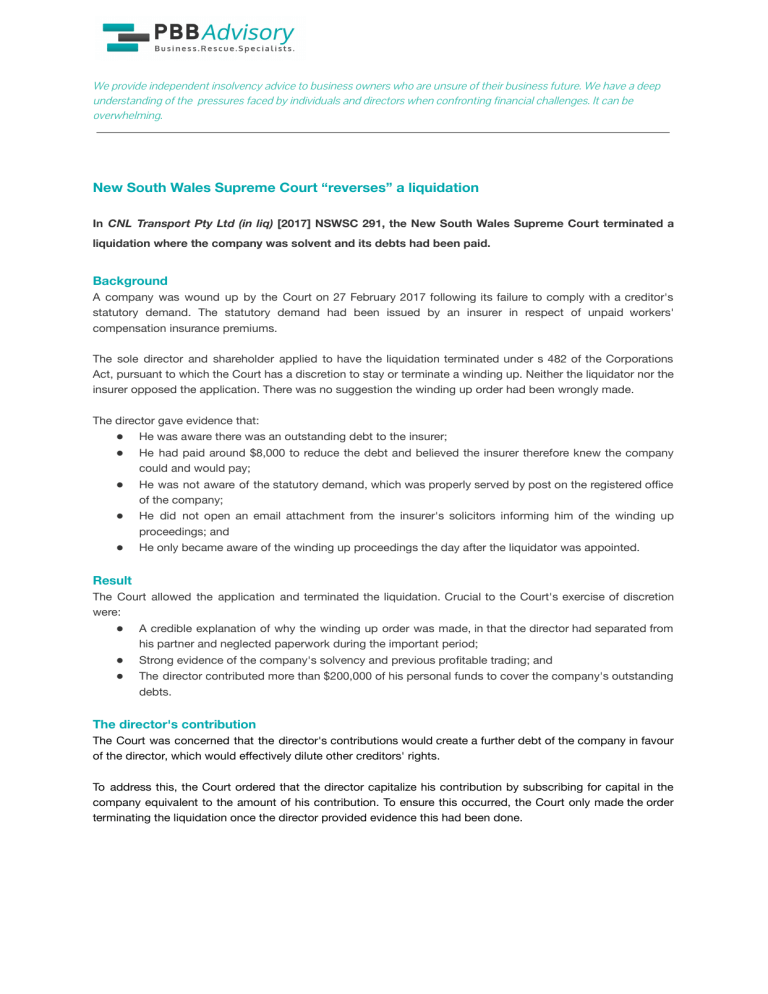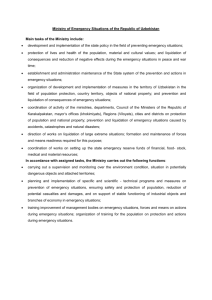
Weprovideindependentinsolvencyadvicetobusinessownerswhoareunsureof their businessfuture.Wehaveadeep understanding of the pressuresfacedbyindividualsand directorswhenconfrontingfinancialchallenges.Itcanbe overwhelming. New South Wales Supreme Court “reverses” a liquidation In CNL Transport Pty Ltd (in liq) [2017] NSWSC 291, the New South Wales Supreme Court terminated a liquidation where the company was solvent and its debts had been paid. Background A company was wound up by the Court on 27 February 2017 following its failure to comply with a creditor's statutory demand. The statutory demand had been issued by an insurer in respect of unpaid workers' compensation insurance premiums. The sole director and shareholder applied to have the liquidation terminated under s 482 of the Corporations Act, pursuant to which the Court has a discretion to stay or terminate a winding up. Neither the liquidator nor the insurer opposed the application. There was no suggestion the winding up order had been wrongly made. The director gave evidence that: ● ● He was aware there was an outstanding debt to the insurer; ● He was not aware of the statutory demand, which was properly served by post on the registered office of the company; ● He did not open an email attachment from the insurer's solicitors informing him of the winding up proceedings; and ● He only became aware of the winding up proceedings the day after the liquidator was appointed. He had paid around $8,000 to reduce the debt and believed the insurer therefore knew the company could and would pay; Result The Court allowed the application and terminated the liquidation. Crucial to the Court's exercise of discretion were: ● A credible explanation of why the winding up order was made, in that the director had separated from his partner and neglected paperwork during the important period; ● ● Strong evidence of the company's solvency and previous profitable trading; and The director contributed more than $200,000 of his personal funds to cover the company's outstanding debts. The director's contribution The Court was concerned that the director's contributions would create a further debt of the company in favour of the director, which would effectively dilute other creditors' rights. To address this, the Court ordered that the director capitalize his contribution by subscribing for capital in the company equivalent to the amount of his contribution. To ensure this occurred, the Court only made the order terminating the liquidation once the director provided evidence this had been done. Weprovideindependentinsolvencyadvicetobusinessownerswhoareunsureof their businessfuture.Wehaveadeep understanding of the pressuresfacedbyindividualsand directorswhenconfrontingfinancialchallenges.Itcanbe overwhelming. Takeaway Don’t despair, the Court may terminate a liquidation where it becomes apparent it is not appropriate. Liquidators who participate in such applications should ensure that there is strong evidence the company is solvent and that a “reversal” will not be detrimental to creditors. Article by Greg MacDonald Partner, PBB Advisory D: 02 8188 2076 greg@pbbadvisory.com.au Last updated: 19 March 2020 Disclaimer: This fact sheet was prepared by PBB Advisory, which has taken great care to ensure the accuracy of its contents. However, the fact sheet is written in general terms and you are strongly recommended to seek specific professional advice before taking any action based on the information it contains. No warranty expressed or implied is given in respect of the information provided and accordingly no responsibility is taken by PBB Advisory or any member of the firm for any loss resulting from any error or omission contained within this fact sheet.

![FORM NO. 157 [See rule 331] COMPANIES ACT. 1956 Members](http://s3.studylib.net/store/data/008659599_1-2c9a22f370f2c285423bce1fc3cf3305-300x300.png)

